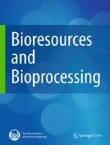Bioresources and Bioprocessing is associated with the State Key Laboratory of Bioreactor Engineering, East China University of Science and Technology.
Rational high-throughput screening system for high sophorolipids production in Candida bombicola by co-utilizing glycerol and glucose capacity
A rational and high-performance high-throughput screening system effectively improves the efficiency of strain screening.










































